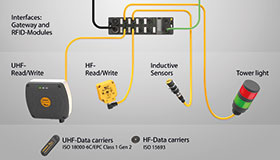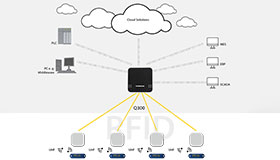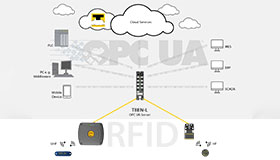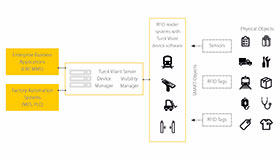RFID

The Crucial Role of Data in Choosing the Right RFID Application Approach
RFID systems have a central task: efficiently providing precise object data. More specifically, it involves reading this data, processing it appropriately for application, and transmitting it to connected systems. By enabling precise data management, RFID systems can accurately track and trace objects, offering critical decision-relevant insights that support the development and optimization of processes and operations. This capability is a key reason why RFID solutions are often chosen for applications where accurate and real-time data is essential.
Two different application scenarios illustrate the crucial role of data in RFID systems. In the first scenario, the focus is on comprehensive data tracking, which originates from various read points during the production and storage of paper rolls. To meet these complex requirements, it makes sense to use UHF RFID and consider a more advanced application such as the TVS solution. In contrast, the second scenario focuses on tracking paper rolls within production machinery, where less comprehensive data integration is required. Here, simpler data capture at individual RFID points, such as using Turck HF/UHF readers, is sufficient.
RFID Solutions for Production and Logistics
End-to-end tracking of incoming and outgoing goods, confirming automatically that the intended materials and tools are being used in production, or providing access points with increased security. For such industrial tasks, RFID has proven itself as a powerful Auto-ID technology for Industry 4.0, with contactless transmission of large amounts of information, even over long distances, and easy connection to higher-level systems from PLC to ERP.

BL ident is Turck's complete modular RFID system, tailored for industrial environments (click to enlarge)
Choosing the right frequency band
HF technology (13.56 MHz) is an important driver of digital production processes, it is based on magnetic near-field communication. However, if higher ranges or bulk readings of 200 data carriers and more are required, users should opt for UHF technology (865...928 MHz). Turck's modular RFID system BL ident enables the parallel operation of read/write heads in the HF and UHF range – and thanks to protection class IP67, this can also be done directly on site at the machine or plant. This allows consistently decentralized signal processing in the field.
Data transfer to higher-level systems
Communication in logistics and production plants today is divided into hierarchically structured levels. RFID readers with an Ethernet interface establish a direct exchange of information with higher-level systems, such as PLC, SCADA, MES and ERP or the cloud. Thus, goods movements are visible in real time, detected goods are matched with the database or, perhaps, automatic invoices are already created in the accounting software.
IIoT applications via OPC UA
The platform-independent communication standard OPC UA simplifies the integration of RFID solutions into PLC, MES, ERP or cloud systems. With the AutoID Companion Specification, it is also possible to exchange devices between Auto-Ident systems from different manufacturers. Turck played a significant role in the development of the standard and has an own RFID interface with OPC UA server in its portfolio. For secure communication, the interface offers mixed operation of HF and UHF read/write heads.
Video: Seamless Identification in Production and Intralogistics
Watch the video to see how Turck's RFID solutions optimize the entire process – from incoming goods to production and outgoing goods.
RFID Solutions: Seamless Identification in Production and Intralogistics
With Integrators and the Right Middleware to Turnkey Applications
Especially for UHF projects, the know-how of system integrators pays off for companies. These specialists not only master the parameterization of read/write heads, for example to exclude interference with other devices, but also take over the installation of middleware. For the systems involved, it is in fact the middleware that makes the information on a data carrier usable - filtering and transmitting or visualizing it as required.
Complete solutions for track-and-trace processes
Since 2018, Turck also offers turnkey RFID complete solutions through its subsidiary Turck Vilant Systems. The RFID specialist has already realized more than 1,000 RFID system installations in 35 countries and increases the efficiency of all track-and-trace processes along the supply chain with reader systems, internally developed middleware and on-site service.
Further Information
- Webinar Recording - RFID Gates in Logistics
- Whitepaper – Six Factors to Consider When Choosing the Appropriate RFID UHF Tag
- Flyer – RFID Solutions for the Automotive Industry
- Flyer – RFID Solutions for the Food and Beverage Industry
- Flyer – Identification Solutions for the Pharmaceutical Industry
- Flyer: RFID Turnkey Solutions for Production, Logistics and more (Turck Vilant Systems)
- Flyer – Modular RFID System BL ident
- Flyer: Q300 – UHF RFID Reader with Ethernet
- Flyer – Compact RFID Module with OPC UA Server
- Flyer – Compact RFID Modules with I/Os
- Flyer – PD ident | PD20 RFID Handhelds
- Topics & Technologies
- Asset Monitoring Gateway with Cloud ID
- Asset Monitoring Gateway with SNAP ID
- Codesys
- Condition Monitoring
- Ethernet in Hazardous Locations
- Field Logic Controller
- Industrial Cloud
- Industry 4.0
- IO-Link
- Machine Safety
- Modular Machines
- Module Type Package
- Multiprotocol Ethernet
- Pick-to-Light
- Profinet
- RFID
- Safe work and Occupancy Monitoring
- Snap Signal
- Sustainability
- TAS – IIoT Service Platform
- The Visual Factory




